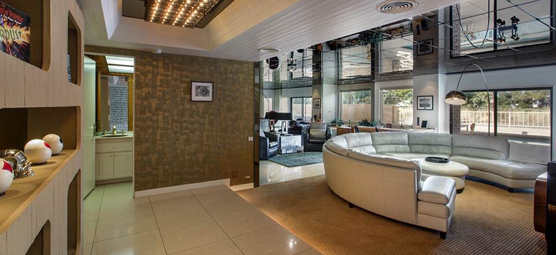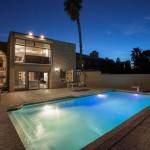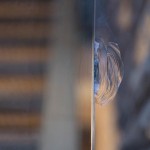Lefty’s house, equipped with bulletproof windows, is on the block

Despite being so safe, the three-bedroom, two-and-a-half bath, two-story house still has a wide-open feel thanks to the expansive windows facing the golf course out back. One window, shown on the right, still has the mark where a bullet hit it.
A house once owned and lived in by one of Las Vegas’ most colorful and famous Mob characters is up for sale.
Frank “Lefty” Rosenthal and his family, during his years running several Las Vegas casinos, lived in the 3,700-square-foot house in the gated Las Vegas Country Club. It was a period when Rosenthal, who had been convicted in a New York state college basketball point-shaving scandal, associated with some well-known mobsters. They included the leadership of the Chicago Outfit, the Milwaukee Mob and a number of Mob associates who had relocated to Las Vegas, including the Outfit’s enforcer, Tony Spilotro. The period is chronicled in the 1995 book Casino, by Nicholas Pileggi, and movie of the same name, directed by Martin Scorsese.
The movie, which had Robert De Niro playing the fictional “Ace” Rothstein as a stand-in for Rosenthal, included the stormy relationship between Rosenthal and his wife, Geri McGee, arguments with (and threats from) Spilotro, and an attempted car-bombing in 1982 that almost killed Lefty.
Rosenthal eventually was banned from the casino business by state regulators and placed in the infamous “Black Book” of people prohibited from entering a casino.
Scorsese did not use the actual Country Club house to make his film, opting for another mid-century home in the Paradise Palms neighborhood nearby. One person who saw Rosenthal’s real-life house was Frank Cullotta, who was a member of Spilotro’s “Hole in the Wall” burglary gang. Cullotta says the real-life house was nicer than the one Scorsese used in the movie.
“I was over there one time with Tony,” Cullotta says. “It was over in the country club. I didn’t roam around the house [but] it was a gorgeous house. It had bulletproof windows. It was much more modern than the one you see in the movie. It was a nice house. Are you kidding me? It was a lot nicer than Tony’s house.”
Brian Burns of Synergy-Sotheby’s International Realty, which has the listing for the property, says the house is everything it’s cracked up to be – although an underground tunnel to a neighboring residence no longer exists since the neighboring house burned down. The Rosenthal house was built in 1970, but was completely remodeled by well-known designers Steve Chase and Arthur Elrod and Associates of Palm Springs in 1974. Many of the design details that Chase and Arthur Elrod created for the house remain, including original artwork. After Rosenthal was banned from the casinos, he still ran the Mob-affiliated resorts from his home, so he wanted a safe (and, because of wiretaps, soundproof) place to work.
“The house is really kind of the Fort Knox of Las Vegas,” Burns says. “He was trying not to be killed by the Mob and trying not to be heard by the FBI.” Burns confirms that windows and doors are bulletproof; one window still has the mark where a bullet hit it. Despite being so safe, the three-bedroom, two-and-a-half bath, two-story house still has a wide-open feel thanks to the expansive windows facing the golf course out back.
A prospective buyer should know that at $777,000 (triple sevens, of course, being a gambler’s number), the house is a little more expensive than some of its neighbors, but that reflects its historic value, Burns says. Those who are interested in buying the house – or just taking a tour – can see it in more detail on YouTube. One person who won’t be bidding for the property is Lefty himself, who died in Miami Beach, Florida, in 2008.
Photos courtesy of J.P.M. Studios/Synergy-Sotheby’s International Realty
Feedback or questions? Email blog@themobmuseum.org








